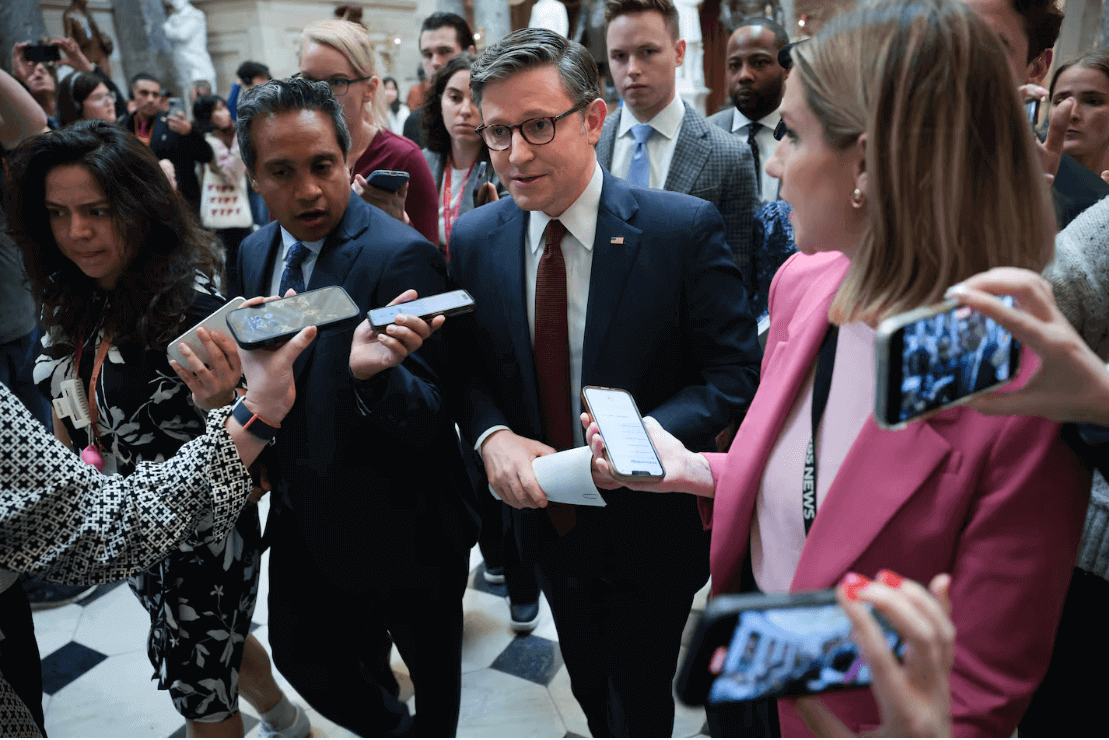众议院共和党推动“大”预算决议通过,这是实现特朗普议程的关键一步

【中美创新时报2025 年 2 月 26 日编译讯】(记者温友平编译)在总统唐纳德·特朗普的推动下,众议院共和党人于周二提交了一份共和党预算蓝图,这是实现他的“大而美丽的法案”的一步,该法案包括 4.5 万亿美元的税收减免和 2 万亿美元的支出削减,尽管遭到民主党人的强烈反对和共和党人的不满。美联社记者 LISA MASCARO、KEVIN FREKING 和 MATT BROWN对此作了下述报道。
众议院议长迈克·约翰逊几乎没有得到共和党多数派的选票,并在所有方面与民主党人、不安的普通共和党人和持怀疑态度的共和党参议员作斗争,以推进该党的标志性立法方案。特朗普致电任性的共和党议员,并邀请共和党人前往白宫。
投票结果为 217 票赞成、215 票反对,只有一名共和党人,所有民主党人都反对,结果在投票前都岌岌可危。
“在这样的投票中,你总是会有人一直和你交谈,直到投票结束,”多数党领袖史蒂夫·斯卡利塞在唱名前说。
“我们成功了,”议长随后表示。
该方案的通过对于启动这一进程至关重要。特朗普希望控制国会的共和党人批准一项大规模法案,该法案将延长他在第一任期内获得但今年晚些时候到期的税收减免,同时削减联邦计划和服务的支出。
在任何事情成为法律之前,接下来的步骤是漫长而繁琐的——数周的委员会听证会起草细节,并将众议院版本提交参议院,共和党人在那里通过了他们自己的缩减版本。未来还有更多重大投票,包括一项无关的协议,以防止联邦政府在 3 月 14 日联邦资金到期时关门。这些谈判也在进行中。
这一切都发生在人们对其他地方发生的事情的强烈反对中,亿万富翁特朗普顾问埃隆马斯克正在通过他的政府效率部在全国范围内解雇数千名员工,愤怒的选民开始在国内的市政厅会议上与立法者对峙。
民主党人在下午的辩论中谴责该计划是对美国人的“背叛”,是“美国衰落的蓝图”,简直是“共和党的骗局”。
“我们作为一个国家的生活方式正受到攻击,”众议院民主党领袖哈基姆杰弗里斯在国会大厦的台阶上说。
在美国人的支持下,民主党人对共和党的预算蓝图发出嘘声,他们表示,削减医疗补助和其他社会项目会伤害他们。但作为少数党,他们没有足够的票数来阻止它。
削减政府开支在国内并不总是受欢迎
尽管共和党人继续推进,但他们也遇到了一个熟悉的问题:削减联邦开支通常说起来容易做起来难。由于削减五角大楼和其他项目的开支基本不受限制,其他大部分政府支出都用于医疗保健、食品券、学生贷款和选民所依赖的项目。
几位共和党议员担心,正在考虑的削减范围——尤其是十年内削减处理医疗保健支出(包括医疗补助)委员会的约 8800 亿美元,或削减资助食品券的农业委员会的 2300 亿美元——将对他们国内的选民造成太大的伤害。
共和党领导人坚持认为,医疗补助并未在最初的 60 页预算框架中明确列出,这是事实。约翰逊和他的领导团队还告诉议员们,在制定最终方案时,他们将有足够的时间来讨论细节。
但立法者希望保证医疗保健计划和其他计划将受到保护,因为这些计划将在未来几周内制定并与参议院合并。
纽约州共和党众议员迈克·劳勒表示,特朗普已承诺不会允许削减医疗补助。
“总统对此很清楚。我也很清楚,”劳勒说。“我们会解决这个问题,但今天的目标是开始这个过程。”
与此同时,共和党赤字鹰派人士一直拒绝支持,直到他们确信这不会增加美国 36 万亿美元的债务负担。他们警告说,由于减税的成本,债务将不断增加,十年内至少 4.5 万亿美元超过了政府项目 2 万亿美元的支出削减。
一位关键的保守派议员、肯塔基州共和党众议员托马斯·马西最终成为唯一投反对票的共和党人。
特朗普邀请了数十名共和党人到白宫,其中包括亚利桑那州共和党众议员胡安·西斯科马尼,他加入了国会西班牙裔大会的一群共和党议员,对保护医疗补助、食品券和大学佩尔助学金表示担忧。
“虽然我们全力支持控制浪费性支出和实现特朗普总统议程的努力,但我们必须不削减支持全国美国社区的项目,”德克萨斯州共和党众议员托尼·冈萨雷斯和其他几位来自西班牙裔会议的共和党议员写道。
民主党抗议为富人减税
众议院和参议院的民主党人发誓要继续反对整个过程。“这不是人们想要的,”马萨诸塞州民主党众议员吉姆·麦戈文在计划投票前的规则辩论中说道。
“我们都知道,涓滴经济学,”他谈到 2017 年主要流向富人的减税时说,“不起作用。”
议员们表示,特朗普已经表示倾向于“大”法案,但他似乎也喜欢众议院和参议院之间的竞争,因为他让共和党人互相竞争,看看哪个版本会出现。
参议院共和党人上周推出了自己的 3400 亿美元一揽子计划。该计划的重点是向特朗普政府提供其目前所需的驱逐和边境安全议程所需的资金,并计划在今年晚些时候单独解决减税问题。
“我屏住呼吸。我祈祷着,”德克萨斯州共和党参议员约翰·科宁说,他支持众议院的做法,认为这是更好的选择。“我认为一次性行动是他们最好的机会。”
众议院共和党面临陷阱
约翰逊的政党在去年 11 月的选举中失去了席位,拥有现代历史上最微弱的多数席位之一,这意味着他必须让几乎所有共和党人保持一致,否则就有失去选票的风险。
预算是在漫长的编制过程中编制的,首先要向众议院和参议院各委员会发出指示,然后各委员会将有几周的时间制定更详细的计划,以进行额外的辩论和投票。
众议院预算委员会共和党主席乔迪·阿灵顿表示,根据经济增长假设,从无党派的国会预算办公室预测的 1.8% 到众议院共和党人预测的 2.6%,该计划将在 10 年内产生约 2.6 万亿美元的节余,并确保该计划有助于减少赤字。
一些财政倡导团体认为共和党的经济预测过于乐观。
美联社记者 Leah Askarinam 和 Stephen Groves 对本文亦有贡献。
题图:众议院议长迈克·约翰逊 (R-LA) 在 2 月 25 日国会大厦投票后离开众议院。Win McNamee/Getty
附原英文报道:
House GOP pushes ‘big’ budget resolution to passage, a crucial step toward delivering Trump’s agenda
By LISA MASCARO, KEVIN FREKING and MATT BROWN The Associated Press,Updated February 25, 2025
Speaker of the House Mike Johnson (R-LA) departs the House chamber following a vote at the Capitol on Feb. 25.Win McNamee/Getty
WASHINGTON — With a push from President Donald Trump, House Republicans sent a GOP budget blueprint to passage Tuesday, a step toward delivering his “big, beautiful bill” with $4.5 trillion in tax breaks and $2 trillion in spending cuts despite a wall of opposition from Democrats and discomfort among Republicans.
House Speaker Mike Johnson had almost no votes to spare in his bare-bones GOP majority and fought on all fronts — against Democrats, uneasy rank-and-file Republicans and skeptical GOP senators — to advance the party’s signature legislative package. Trump made calls to wayward GOP lawmakers and invited Republicans to the White House.
The vote was 217-215, with a single Republican and all Democrats opposed, and the outcome was in jeopardy until the gavel.
“On a vote like this, you’re always going to have people you’re talking to all the way through the close of the vote,” Majority Leader Steve Scalise said before the roll call.
“We got it done,” the speaker said afterward.
Passage of the package is crucial to kickstarting the process. Trump wants the Republicans who control Congress to approve a massive bill that would extend tax breaks, which he secured during his first term but are expiring later this year, while also cutting spending across federal programs and services.
Next steps are long and cumbersome before anything can become law — weeks of committee hearings to draft the details and send the House version to the Senate, where Republicans passed their own scaled-back version. And more big votes are ahead, including an unrelated deal to prevent a government shutdown when federal funding expires March 14. Those talks are also underway.
It’s all unfolding amid emerging backlash to what’s happening elsewhere as billionaire Trump adviser Elon Musk is tearing through federal agencies with his Department of Government Efficiency firing thousands of workers nationwide, and angry voters are starting to confront lawmakers at town hall meetings back home.
Democrats during an afternoon debate decried the package as a “betrayal” to Americans, a “blueprint for American decline” and simply a “Republican rip-off.”
“Our very way of life as a country is under assault,” House Democratic Leader Hakeem Jeffries said on the steps of the Capitol.
Flanked by Americans who said they would be hurt by cuts to Medicaid and other social programs, the Democrats booed the GOP budget blueprint. But as the minority party, they don’t have the votes to stop it.
Slashing government is not always popular at home
Even as they press ahead, Republicans are running into a familiar problem: Slashing federal spending is typically easier said than done. With cuts to the Pentagon and other programs largely off limits, much of the other government outlays go for health care, food stamps, student loans and programs relied on by their constituents.
Several Republican lawmakers worry that scope of the cuts being eyed — particularly some $880 billion over the decade to the committee that handles health care spending, including Medicaid, for example, or $230 billion to the agriculture committee that funds food stamps — will be too harmful to their constituents back home.
GOP leaders insist Medicaid is not specifically listed in the initial 60-page budget framework, which is true. Johnson and his leadership team also told lawmakers they would have plenty of time to debate the details as they shape the final package.
But lawmakers wanted assurances the health care program and others will be protected as the plans are developed and merged with the Senate in the weeks to come.
Rep. Mike Lawler, R-N.Y., said Trump has promised he would not allow Medicaid to be cut.
“The president was clear about that. I was clear about that,” Lawler said. “We will work through this, but the objective today is to begin the process.”
At the same time, GOP deficit hawks were withholding support until they were convinced it wouldn’t add to the nation’s $36 trillion debt load. They warned it will pile onto debt because the cost of the tax breaks, with at least $4.5 trillion over the decade outweighing the $2 trillion in spending cuts to government programs.
One key conservative, Rep. Thomas Massie, R-Ky., ended up the sole GOP vote against.
Trump had invited several dozen Republicans to the White House, including Rep. Juan Ciscomani, R-Ariz., who joined a group of GOP lawmakers from the Congressional Hispanic Conference raising concerns about protecting Medicaid, food stamps and Pell grants for college.
“While we fully support efforts to rein in wasteful spending and deliver on President Trump’s agenda, it is imperative that we do not slash programs that support American communities across our nation,” wrote Rep. Tony Gonzales, R-Texas, and several others GOP lawmakers from the Hispanic Conference.
Democrats protest tax cuts for wealthy
Democrats in the House and the Senate vowed to keep fighting the whole process. “This is not what people want,” said Rep. Jim McGovern, D-Mass., during a rules debate ahead of planned votes.
“We all know that trickle-down economics,” he said about the 2017 tax breaks that flowed mainly to the wealthy, “don’t work.”
Trump has signaled a preference for “big” bill but also appears to enjoy a competition between the House and the Senate, lawmakers said, as he pits the Republicans against each other to see which version will emerge.
Senate Republicans launched their own $340 billion package last week. It’s focused on sending Trump money his administration needs for its deportation and border security agenda now, with plans to tackle the tax cuts separately later this year.
“I’m holding my breath. I’m crossing my fingers,” said Sen. John Cornyn, R-Texas, who said he was rooting for the House’s approach as the better option. “I think a one-shot is their best opportunity.”
The House GOP faces pitfalls ahead
Johnson, whose party lost seats in last November’s election, commands one of the thinnest majorities in modern history, which meant he had to keep almost every Republican in line or risk losing the vote.
The budget is being compiled during a lengthy process that first sends instructions to the various House and Senate committees, which will then have several weeks to devise more detailed plans for additional debate and votes.
Rep. Jodey Arrington, the Republican chairman of the House Budget Committee, said with economic growth assumptions, from 1.8 percent as projected by the nonpartisan Congressional Budget Office to 2.6 percent as projected by House Republicans, the package would generate about $2.6 trillion in savings over 10 years and would ensure the plan helps reduce the deficit.
Some fiscal advocacy groups view the GOP’s economic projections as overly optimistic.
Associated Press writers Leah Askarinam and Stephen Groves contributed reporting.

